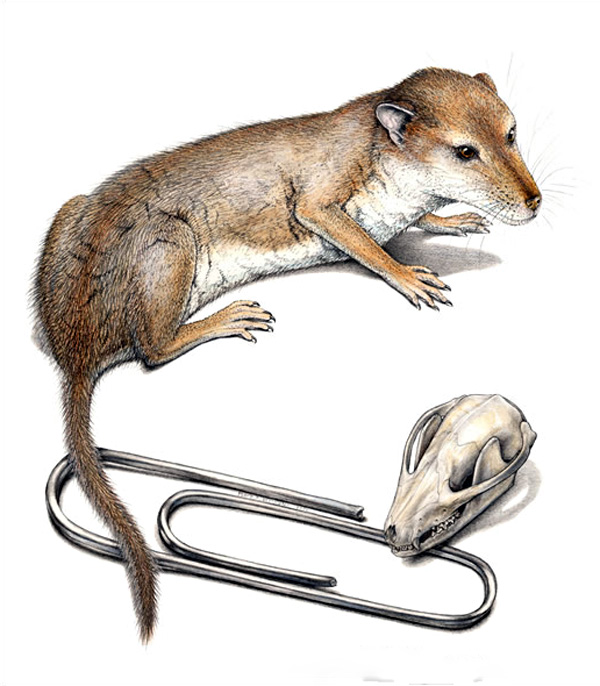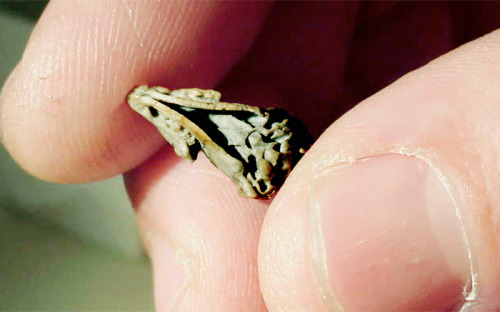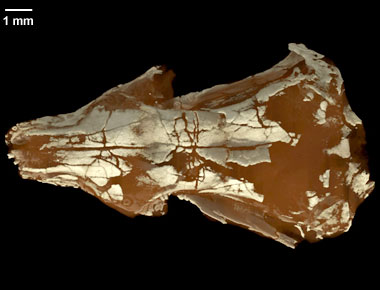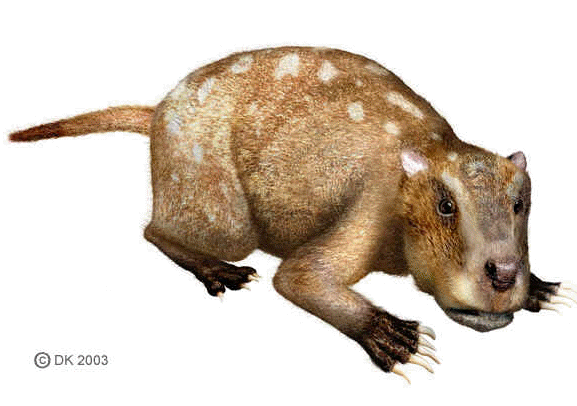[Recent Entries][Archive][Friends][User Info]
January 28th, 2013
| January 28th, 2013 | |
|---|---|
| 06:35 pm [industrialterro] [Link] |
Hadrocodium Hadrocodium wui is an extinct basal mammal species that lived during the Lower Jurassic (approx. 195 million years ago, during the Sinemurian stage) in what is now the Yunnan province of China. Hadrocodium was a mere 3.2 cm (1.35 in) in length (about 2 grams), making it one of the smallest mammals ever. Hadrocodium is the earliest known example of several features possessed only by mammals, including mammal-like mandible, middle-ear structures, and a relatively large brain cavity. These features had been considered limited to crown group mammals; the discovery of Hadrocodium suggests that they appeared much earlier (45 million years earlier) than previously thought. Whether Hadrocodium was endothermic or cold-blooded has not been settled, although its apparent nocturnal features would seem to place it in the endotherm group. Вопрос о том, как эволюционировал мозг млекопитающих и что послужило главным толчком к его развитию, до сих пор остается открытым и вызывает немало вопросов в научной среде. Так, известно, что первые млекопитающие появились на земле более чем 200 млн лет назад, к числу их предков относятся так называемые цинодонты. Цинодонты являлись промежуточным звеном между рептилиями и млекопитающими, они обладали маленьким мозгом, а также слабо развитыми структурами, отвечающими за распознавание запахов, — обонятельными луковицами. От цинодонтов и произошли первые млекопитающие, которые, в общем-то, тоже не могли похвастаться мощными сенсорными способностями. В дальнейшем их мозг совершенствовался, усложнялись отдельные его структуры, увеличивалась функциональная нагрузка, однако, что конкретно провоцировало «мозговую» эволюцию, остается непонятным. Одни исследователи предполагают, что немалую роль в этом процессе сыграло развитие слухового аппарата, другие же отдают предпочтение влиянию зрительных функций. Ученые из Техасского университета в США предполагают, что ни слух, ни зрение не сыграли такого большого значения для совершенствования структур головного мозга млекопитающихся, как обоняние. Работа техасских исследователей опубликована в журнале Science. Команда палеонтологов во главе с профессором Тимом Роуе (Tim Rowe) из Лаборатории палеонтологии позвоночных при Техасском университете, используя рентген, проанализировала структуру черепа двух предков млекопитающих Morganucodon oehleri и Hadrocodium wui, живших приблизительно 200 млн лет тому назад. Получив рентгеновские снимки отдаленных участков черепа древних предков и наложив их друг на друга в определенной последовательности, ученые получили своеобразную трехмерную картинку— «эндокаст», которая позволяла разобраться в строении и особенностях останков исходя из отпечатков мозговых структур, оставшихся на костях черепа. Сами останки при этом оставались неповрежденными. Полученные картинки показали, что мозг Morganucodon oehleri по своим размерам превосходит мозг цинодонтов приблизительно в два раза и что пропорциональное соотношение головы Hadrocodium wui к телу оказалось таким же, как и у млекопитающих. В ходе эксперимента также стало ясно, что обонятельные структуры (обонятельная луковица и кора) занимали большую часть мозга древних предков млекопитающих, а Hadrocodium wui даже превосходил Morganucodon oehleri по своим «нюхательным» способностям, так как обладал более развитыми обонятельными долями. Ученые также предполагают, что древние предки современных млекопитающих, помимо мощного обоняния, обладали также неплохими навыками координации. У млекопитающих за распознавание запахов отвечает в 10 раз больше генов, по сравнению с другими животными. Возможно, что первые истинные млекопитающие обладали еще более мощными обонятельными способностями, чем их миниатюрные предки. Отвечая на вопрос о том, а зачем вообще Morganucodon oehleri и Hadrocodium wui нужно было настолько чуткое обоняние, авторы работы высказали предположение: «Возможно, что эти мелкие зверьки охотились ночью. Днем же на охоту выдвигались динозавры. Мы предполагаем, что первые млекопитающие в большинстве своем вообще были ночными животными».
Ископаемые останки и реплики (1, 2, 3):
Tags: Вымершие млекопитающие, Юра |
| Time | Event |
| 07:14 pm [industrialterro] [Link] |
Docodon Docodon (meaning 'beam tooth') was an omnivorous mammal from the middle to upper Jurassic Period that lived in Europe and North America approximately 175.6 to 144 million years ago. Docodon likely inhabited woodland and stayed in trees out of the reach of predators. Weather Docodon was a true mammal is under debate, and some suggest it was an evolved therapsid or mammal like reptile. Docodon had complex teeth, which suggest it had a diverse diet. The dentition patterns of the cusps and other molars are complex and distinct and closely resemble that of mammals, but Docodon and other docodonts are only distantly related to living mammals. It was first discovered by Othniel Charles Marsh in 1880. Like other early small mammals it is known only from fossilized teeth since the rest of the body did not fossilize as efficiently. Docodon fossils are found most commonly at the 'Morrison Formation of the Black Hills' and suggest a possible habitat preference. Its height is estimated at 10 centimeters with a length of 4 inches and approximate weight of 1 once. A 2006 study by J. R. Foster concluded it is the most massive mammal genus of the formation. Docodonta is an order of extinct mammaliaforms that lived during the mid- to late-Mesozoic era. Their most distinguishing physical features were their relatively sophisticated set of molars, from which the order gets its name. In the fossil record, Docodonta is represented primarily by isolated teeth and bits of jawbones. While most of these specimens have been found across former Laurasia (modern-day North America, Europe, and Asia), some have also been found from Gondwana (modern-day India and Southern Hemisphere). Docodonts are not quite as closely related to the placentals and marsupials as the monotremes are, so they are not included among the crown-group mammals. Because of the complexity of their molars and the fact that they possess the dentary-squamosal jaw joint, though, they have generally been regarded as mammals. Some authors do limit the term "Mammalia" to the crown group, however, excluding mammaliaforms like the docodonts. Docodonts are thought to have been primarily herbivorous or insectivorous, although Castorocauda has teeth which suggest it ate fish.
Tags: Вымершие млекопитающие, Юра, докодонты |
| Time | Event |
| 07:25 pm [industrialterro] [Link] |
Castorocauda Касторокауда (Castorocauda lutrasimilis) — вымерший синапсид, ведший полуводный образ жизни. Жил в среднем юрском периоде, около 164 миллионов лет назад. Ископаемые останки обнаружены в отложениях массива Даохугоу (вероятно, часть формации Цзюлуншань) во Внутренней Монголии (КНР). Касторокауда была сильно специализированным видом. По образу жизни напоминала современных полуводных млекопитающих — таких, как бобр, нутрия и утконос. Название рода Castorocauda происходит от латинских слов «castor» (бобр) и cauda (хвост); название вида lutrasimilis означает «подобный выдре». Предполагается, что животное весило около 500—800 граммов, а длина тела достигала 42,5 сантиметров. Таким образом, касторокауда была крупнейшим синапсидом (предком млекопитающих) юрского периода. Касторокауда входит в состав отряда Docodonta, входящего в надотряд Mammaliaformes, к которому, наряду с вымершими видами, относятся и современные млекопитающие. Среди докодонтов Castorocauda находилась в ближайшем родстве с европейскими видами Krusatodon и Simpsonodon, что свидетельствует об обмене фауной между Европой и Азией в период среднеюрского периода. Позднее между этими будущими континентами образовался Тургайский пролив. A fossil discovery was made in 2004 in the fossil-rich beds of Liaoning province, China; it was reported in the journal Science by an international team led by Qiang Ji of Nanjing University. The fossil of Castorocauda was so well preserved that an important feature of its soft anatomy— hair— was preserved. Hair is present in all modern mammals and was therefore assumed, under principles of maximum parsimony, to have been present in all fossil true mammals. The presence of hair in Castorocauda indicates that hair was not only present in mammals, but also in their closest relatives, the docodonts. In fact, the hair appears to have been a very advanced dense pelage including guard hairs and underfur. The tiny auditory ossicles of the middle ear and associated areas were also well preserved in this Castorocauda fossil. Features of these bones confirms the evolutionary position of docodonts as less closely related to true mammals than Hadrocodium, but more closely related to mammals than other mammaliaforms such as Morganucodon. The name Castorocauda lutrasimilis is derived from the Latin castor- meaning "beaver", -"cauda" meaning "tail", lutra meaning "otter", and -similis meaning "similar to". The tail was broad with scales interspersed with hairs that grew less frequent toward the tip. Overall it was very similar to the tails of modern beavers and was presumably used for locomotion in water in a similar fashion. The caudal vertebrae were flattened dorso-ventrally and similar overall to those in a beaver or otter. Fossilized impressions of some webbing is also present between the toes. Features of the limbs suggested that it may have been adapted for digging. The forelimbs are robust, with enlarged olecranon and other processes associated with strong muscle attachment. The limbs are similar to the modern platypus, an animal that both digs and swims. Castorocauda, Haldanodon and perhaps other docodonts were fossorial. These early specializations were also present in the unique early true mammal Fruitafossor. Docodonts in general have distinctive teeth, and the teeth of Castorocauda have the distinguishing features of the group. The teeth of Castorocauda are different in many ways from all other docodonts, presumably due to a difference in diet. Most docodonts had teeth specialized for an omnivorous diet. The teeth of Castorocauda suggest that the animal was a piscivore, feeding on fish and small invertebrates. The first two molars had cusps in a straight row, eliminating the grinding function suggesting that they were strictly for gripping and not for chewing. This feature of three cusps in a row is similar to the ancestral condition in mammal relatives (as seen in triconodonts), but is almost certainly a derived character in Castorocauda. These first molars were also recurved in a manner designed to hold slippery prey once grasped. These teeth are very similar to the teeth seen in mesonychids, an extinct group of semi-aquatic carnivorous ungulates, and resemble, to a lesser degree, the teeth of seals. The complete dental formula was not recoverable, but the lower jaw contained 4 incisors, 1 canine, 5 premolars, and 6 molars. The discovery of Castorocauda lutrasimilis is the first sign that a close relative of mammals adapted to water before dinosaurs lost dominance 65 million years ago, pushing back the estimated date for mammal relatives adapted to a semi-aquatic lifestyle by 110 million years. Based on fossils known at present, the mammal line would not see another semi-aquatic form evolve until the Eocene. Because few fossilized remains had been found, it was previously thought that, until the Cretaceous–Paleogene boundary (K–T boundary), all mammals were tiny, ground-dwelling or tree-dwelling, nocturnal animals akin to shrews, hedgehogs, treeshrews, or tenrecs. This notion has now been falsified by the armadillo-like Fruitafossor, the dinosaur-eating Repenomamus, the flying squirrel-like Volaticotherium and now the otter-like Castorocauda. ( Read More )
Tags: Вымершие млекопитающие, Юра, докодонты |
| Previous Day | 2013/01/28 [Archive] |
Next Day |









